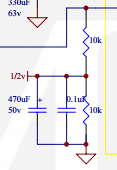thebigkevdogg
Member
- Joined
- Jan 10, 2014
- Messages
- 5
Hi All!
First of all thanks for taking the time to hopefully help a newbie who probably just did something stupid! I'm building a standard 312 circuit with some Yamaha input transformers/op amps I came across from a pm1000. I'm going without an output transformer, and using the post-op amp logic from the JLM BA kit schematic, just a 51 ohm resister and 470uF cap in series to pin 2 with a 10K resister to ground from pin 2 as well. Same for pin 3, but all originating from ground.
I'm powering it all off of a 48v power supply which I made a little circuit to give me a 24v rail as well. I'm wiring the 24v to the common of the op amp, gnd to V-, and 48v to V+. Otherwise it's pretty much a standard 312 circuit.
Anyway, I think I've screwed something up as I'm getting a high pitch whine/noise that is unbearable. Otherwise the circuit, including the gain knob seems to work. I see about .02V from GND to output pin 2 which I figure might be a clue that something has gone amuck. I also get a little spark when I connect my power. The noise is not present until after I connect power. It is definitely amplifying the signal a ton.
Here is a sound sample:
https://www.dropbox.com/s/xevsriu1rnvady7/312_clone_noise.wav
When I zoom in on it in pro tools it seems to be pretty random.
More specifics:
Input transformer: Yamaha GA8027
Op amp: Yamaha NE 80100
Thanks so much for taking the time to read this and help. I don't really know where to start debugging.
Kevin
First of all thanks for taking the time to hopefully help a newbie who probably just did something stupid! I'm building a standard 312 circuit with some Yamaha input transformers/op amps I came across from a pm1000. I'm going without an output transformer, and using the post-op amp logic from the JLM BA kit schematic, just a 51 ohm resister and 470uF cap in series to pin 2 with a 10K resister to ground from pin 2 as well. Same for pin 3, but all originating from ground.
I'm powering it all off of a 48v power supply which I made a little circuit to give me a 24v rail as well. I'm wiring the 24v to the common of the op amp, gnd to V-, and 48v to V+. Otherwise it's pretty much a standard 312 circuit.
Anyway, I think I've screwed something up as I'm getting a high pitch whine/noise that is unbearable. Otherwise the circuit, including the gain knob seems to work. I see about .02V from GND to output pin 2 which I figure might be a clue that something has gone amuck. I also get a little spark when I connect my power. The noise is not present until after I connect power. It is definitely amplifying the signal a ton.
Here is a sound sample:
https://www.dropbox.com/s/xevsriu1rnvady7/312_clone_noise.wav
When I zoom in on it in pro tools it seems to be pretty random.
More specifics:
Input transformer: Yamaha GA8027
Op amp: Yamaha NE 80100
Thanks so much for taking the time to read this and help. I don't really know where to start debugging.
Kevin



